Can a Drone Fly in Strong Winds?
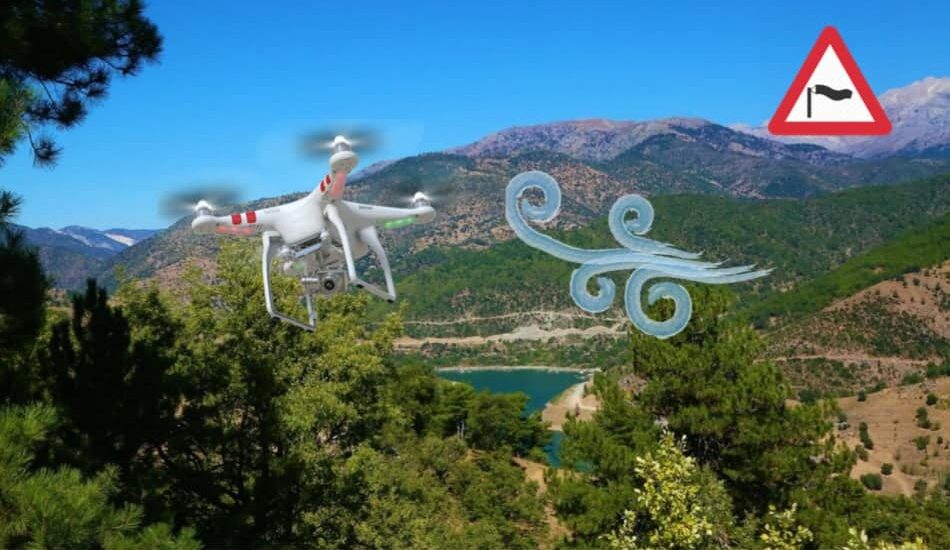
Flying a drone in strong winds can be really dangerous. So I know people are gonna do it anyway and I’m going to try to teach you how to do it as safely as possible, but anytime there’s wind it’s really increasing the chances that you will wreck your drone and maybe even hurt somebody. So let’s first see how drones behave in strong winds.
So Can a Drone Fly in Strong Winds? Yes, drones can fly in the wind. However, when flying in the wind, make sure that the wind speed does not exceed approximately 35 mph. For flying your drone in strong winds you must first check the specifications of your drone, try to avoid high altitudes, fly out upwind and make sure your battery is full.
| Quick Tips For Flying a Drone in Strong Winds | |
|---|---|
| 1. | Full Battery |
| 2, | Fly Out Upwind; RTH Downwind |
| 3. | Avoid Trees & Buildings |
| 4. | Avoid High Altitude |
| 5. | Remote Landing Retrieval |
| 6. | Pro: OA Sensors Off or Sports Mode |
How Strong Wind Affects Your Drone?
The first thing you need to know when flying a drone in strong winds is that the wind drastically affects a lot of factors on your drone. Most of the time they are always exposed to some winds as they fly. The pilot should be behind his drone facing the wind so that if something happens to the drone, so he can catch and secure that same drone. You should also know that during high winds, the engine and propeller will be a little bit louder than usual, due to the higher battery consumption.
If your drone can’t fight strong winds, especially if you get to higher altitudes, than you need to come down right away and land your drone. You also need to be in an open area that if the wind does catch your drone, you can land it safely and walk over to it.
The max speed of your drone flying downwind, should be your drones max speed plus the downwind airspeed, but some drones are limited based on the GPS data. So if you do want to exceed that speed, drop it into ATTI mode. Also be careful when flying around huge gusts around cliffs, so you must be careful to not lose your drone forever in situations like that.
Things to Consider When Flying in Strong Winds
Wind is one of the key factors that can affect a drone and its flying time. In strong winds, the drone uses more energy, significantly straining the battery and shortening its flight time. If you fly in the direction of the wind, your energy consumption will be even greater, and the drone will travel much less distance than it can without the wind.
If you fly high enough in high winds, you will have very little control over the drone. Especially if you want to navigate it sideways or rotate it. The signal could also be delayed, and thus the drone could make sudden movements. So try to keep the drone as low as possible while flying, and don’t do acrobatics during the wind.
Drones have multiple modes, and in the wind it would be best to use ATTI or manual mode. You can see more about the different modes that drones have HERE. When using GPS mode you have a defined flying speed, so read the instructions on how far your drone can reach maximum speed. Sports mode makes quite a good difference when flying.
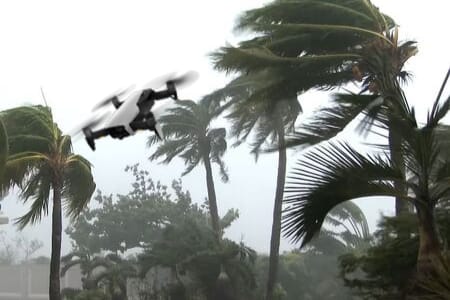
Know The Maximum Speed Of Your Drone
This is very important factor because if the wind speed is higher than the maximum speed of your drone then you will not be able to fly your drone. You can generally check out the manufacturers specs to find that out, but know that that’s not always true.
In particular, for example the DJI inspire 2 is software limited to 55 miles/hour. And even if it could go faster, the software won’t let it. The reason you want to know the max speed of the drone is because the speed is always relative to air speed. Once you lift off, and if you are flying your drone in 30 mph winds, it’s going to be tilted sideways up to wind.
It’ll be hovering in place using its GPS. You will run out of batteries quickly when you are flying upwind, but it will use less batteries when it’s flying downwind. That’s important to know, because if you fly downwind first and you burn up half your batteries and you think the other half is gonna be able to get your drone home, it’s not! If you want to learn more about drones and how they behave, this is a book from Amazon I recommend: Drones (The Ultimate Guide)
Use Sport Mode While Flying at Strong Winds
Most of the drones, like DJI come in P mode, which does not enable the top speeds during the flight (if you’re limited to 15 mph in P mode, you won’t be able to fight winds that are over that limited speed). Be able to put your drone into sport mode. You have to set this mode manually and it is not turned on by default in the DJI Go app, so you need to activate it. When you take off and land, take off in an area that has the wind blocked (like next to buildings or a car).
If you try to take off in heavy winds, that drone will just tip over as it’s starting to take off, it’ll lift a little bit off the ground and lost friction from the ground and crash. So you need a big open area that’s blocked from the wind in order to land it safely.
If you know the wind speed you can roughly caluculate the maximum speed of your drone flying upwind or downwind. Your upwind speed is your drones maximum speed, minus the wind speed. Your downwind speed is your drones maximum speed plus the wind speed. So if you’re trying to set some sort of drone speed record take it out on a windy day and fly it downwind. But know that you’re probably not going to be able to get your drone back after that.
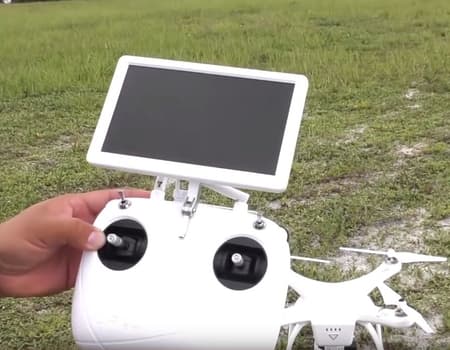
Tips for Flying a Drone in Strong Winds
Flying in high wind really should be avoided and it brings additional risks that you can do without, but if you for whatever reason feel you have to fly, there are some things you can do to mitigate those risks. So lets see most important factors before flying in strong winds:
| 1. | Always make sure you fly with a full battery. Stop taking risks and stop pushing your drone to the limit. |
| 2. | Try to protect your drone during the take off, and turn it to the side where the wind is blowing. Also, stay away from the drone when taking off, and keep a safe distance. |
| 3. | When you fly, fly out into the wind, so that you're drone is returning with the wind. This stops you being caught out by being too far away and finding out the hard way that you can't make it back. |
| 4. | Stay away from trees, people and buildings. That's good advice for any flight, but all the more so, if it's windy you might suffer the odd signal loss and unexpected movement with your drone. |
| 5. | During the flight, sudden unforeseen movements can occur and these drones may overreact. Therefore, it would be advisable to set the control signals so that they are smooth. |
| 6. | Try flying a little lower. The winds normally increase the higher you go and quite often when you are very close to the ground you'll only have a strong breeze. So try to go 40 or 50 meters up into the air, because higher than that and you'll be exposed to even stronger winds. |
| 7. | Fly over a wide open area, where you can easily retrieve your drone if you have to make an emergency landing. |
| 8. | When landing, it is advisable that the drone front faces the wind. This will avoid potential slipping and damage to your drone. |
How to Determine The Current Wind State?
So how can you measure something that you can’t even see? What you may be most interested in before stepping outside and deciding to use your drone is the current state of the wind. Is it possible to determine it and how? What I can tell you is that after a while you can develop a really good feeling and judgment as to whether you can use your drone outside or not, but there are also instruments that can be used to measure wind accurately.
Although we cannot see wind, we can feel it. Forecasters try to work out where wind will blow and what weather the wind will bring. Wind direction and wind speed are the most important factors we need to know. We have different words to describe how fast a wind is blowing. A gust is a sudden rush of wind which can catch you by surprise. A gale is a very powerful wind, and its hard to stand up in front of him.
Anemometer: Scientists use an instrument called an anemometer, to measure the wind’s speed, and this device is also used in meteorological stations. An anemometer has cups that catch the wind, causing it to rotate. The speed of rotation is used to determine the wind speed. Also this instrument measures wind at the current altitude at which it is set, while the wind may be even stronger at higher altitudes, so this should be taken into account.
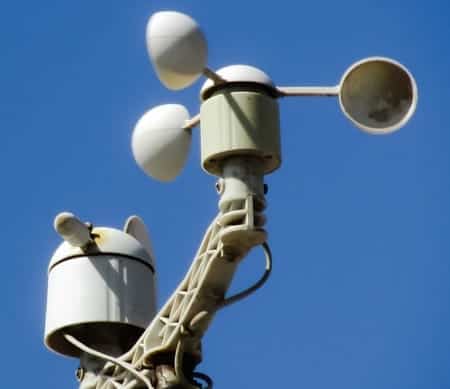
Mobile Apps: There are a couple of applications that show the current state of the wind, and I think that every single drone user should have. There is an app called Windy, and it will tell you the direction of the wind, are there any clouds near and everything that is based on wind specifications. For someone who’s flying a drone, this is definitely one of the best apps on the market. So if you see harder winds it will be difficult to fly and stabilized your drone.

Avoid Flying Above Water During Winds
The worst place where you can see your drone land is in the water. Yes I know that flying over water is tempting, I have done it a loot of times, however, during the strong winds, avoid it! Drones contain a bunch of chips and electronics inside, and they are very sensitive to water, therefore any contact with water is a potential risk for them.
So if you see your drone drown in the water, don’t jump into the water to save it under any price if it can endanger your life, because that’s just a bunch of electronics. More about this topic you can read HERE. I know that it is sometimes very difficult not to record some great footage of waterfalls when you find yourself in the opportunity, but if you don’t need to fly near water, just don’t! And make sure to check everything before flying.
Related Article: 10 Best Wind Resistant Drones For High Winds
Why AirSpeed and GroundSpeed Are Important?
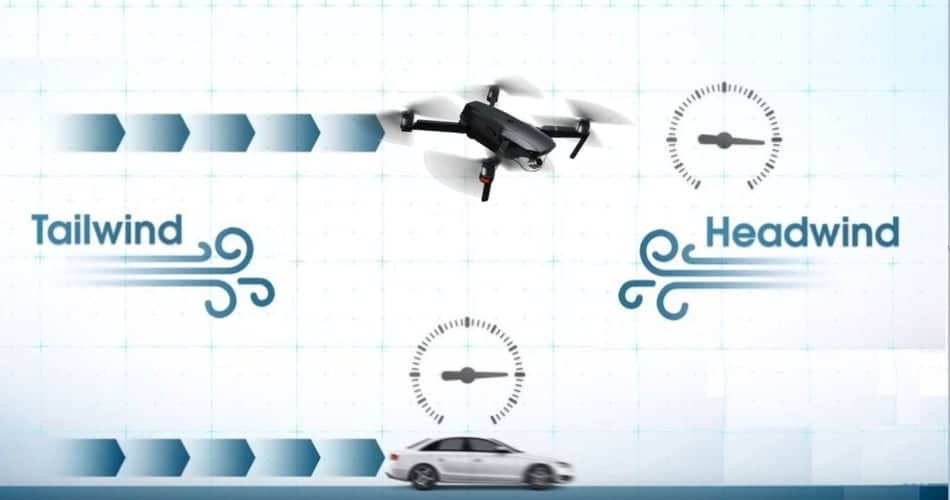
If you are one of those enthusiasts who likes to use drones during strong winds, this is what you should know. To answer the question of how fast you are flying, first of all you should understand the difference between the GroundSpeed vs AirSpeed.
When you are traveling by the car the speed you are going is being measured relatively to the ground. When you are flying a drone in no wind condition, the drone speed would be measured relatively to the ground as we would travel by car. So in this case the distance traveled per unit of time would also be the same.
However when the wind appears, it’s a game-changer. Because of the wind the air moves itself, therefore even though you will be flying at the same speed, your travel distance relative to the ground will be different. You will travel further or your speed relative to the ground will differ from the speed relative to the air. In aviation GroundSpeed is expressed as GS.
There are many AirSpeeds, but the speed that corresponds to the movement relative to the air is called TrueAirSpeed or TAS. In case of wind blowing from behind, our ground speed will be higher than TrueAirSpeed. In other hand, car will need reach same distance as with drone, because drone get some help from the wind. In opposite conditions, while having headwind, car would need less speed than the drone traveling the same distance, because of the wind blowing from the drone head.
Types of Winds That Drones Encounter
Wind can be interpreted as the movement of air caused by the uneven heating of the Earth by the sun, and by the rotation of the Earth itself. Winds can range from light breezes to large types such as hurricanes and tornadoes.
There are so many types of winds, but we will focus only on the ones that most often come in contact with drones. We could say that there are a couple of types of winds that drones encounter during flight. These are the types of winds that are mostly constant and blow at the same speed in populated areas like cities. There are also planetary winds, which mostly blow throughout the year from one part of the earth’s atmosphere to another due to differences in air pressure.
We have also heat winds that can be quite strong, and are caused by the warm air that is heated on the ground by the sun. There are also local winds, which are caused by differences in temperature and air, and there are four types such as: hot, cold, slope and convectional.
Conclusion
So things to keep in mind when you’re flying the drone is that you have to fly it to your comfort level. Don’t get too close to things or too low to the ground, don’t go over people and don’t get too close to the water because you never know could gust of wind just mess up the drone.
If you fly your drone higher it could be even windier up there, so just definitely fly with your comfort level. So if you’re new in drone world, don’t go out to get some footage during the strong wind, because it’s not worth it.

